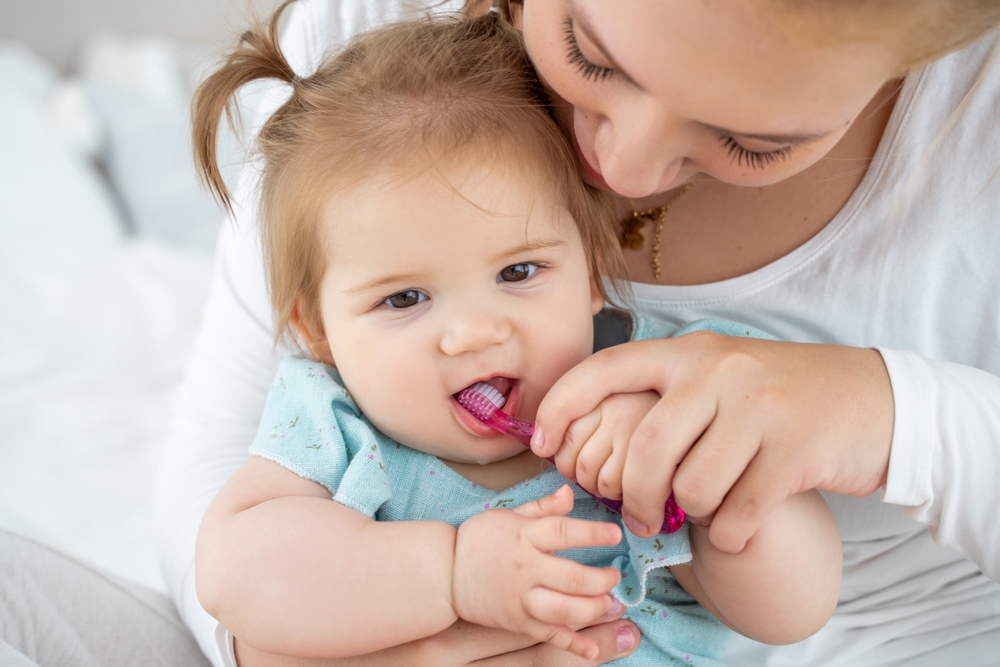
Brushing Baby Teeth – Everything You Need to Know
Taking care of your child’s baby teeth helps prevent problems as their adult teeth grow in. Many parents wonder when to start brushing, how to do it properly, and whether it’s even necessary to brush baby teeth.
This guide answers those questions and gives you practical steps to support your child’s dental health from the start.
Should You Brush Baby Teeth? – Yes
Brushing baby teeth is necessary because they can get cavities just like adult teeth.
Even though baby teeth fall out, they stay in your child’s mouth for years and play a role in eating, speech, and guiding adult teeth into position. If baby teeth develop cavities or infections, they can damage the permanent teeth forming beneath them. Infections can also spread, causing pain and even systemic health issues in rare cases.
Leaving baby teeth untreated can also affect your child’s eating and sleep. The discomfort of a cavity can lead to trouble chewing and less interest in food. Some children miss school because of dental issues. Brushing helps avoid those situations and builds healthy routines early.
When to Start Brushing Baby Teeth
Start brushing your child’s teeth as soon as they appear, even if it’s only one or two.
Many parents wait until their child has a full set of teeth, but bacteria can build up on even one tooth. Starting early not only helps remove bacteria, but also teaches your child that brushing is a normal part of the day. It’s easier to introduce brushing before your child becomes more independent and resistant to new routines.
Use a soft-bristled toothbrush and a small amount of toothpaste. Once your child turns three, you can begin using a pea-sized amount. Before that, stick to a smear the size of a grain of rice.
How to Brush Baby Teeth
Parents need to brush for their child until the child can do it effectively on their own.
The best way to brush baby teeth is by using a small, soft toothbrush with a flat head. Brush twice a day — in the morning and before bed. Use gentle circles on all sides of each tooth, including the gums. Brushing should take about two minutes.
Here’s a simple brushing routine:
- Sit your child on your lap, facing away from you, or stand behind them in front of a mirror.
- Use one hand to lift the upper lip or hold the chin gently.
- Brush all surfaces of the teeth: front, back, and chewing surface.
- Encourage your child to spit out toothpaste but don’t worry if they swallow a small amount.
A silicone toothbrush may look easier, but it doesn’t clean as well as bristles. Once baby teeth have erupted, switch to a standard toothbrush for more effective cleaning.
Children need help brushing until they can tie their own shoelaces. This guideline relates to manual dexterity. Most kids aren’t ready to brush or floss well on their own until around age 7 or 8.
See also: How to Know If Your Child Has Cavities
Habit Building is Important
Building daily brushing habits helps your child accept oral care as part of life.
When brushing is part of the routine, your child is less likely to resist it. Keep brushing time predictable — after breakfast and before bed — and pair it with other parts of their routine, like putting on pyjamas. Use songs, stories, or timers to make brushing more fun.
You can also:
- Brush your own teeth at the same time to model the habit.
- Let your child “brush” your teeth to make it playful.
- Offer a small reward, like stickers or extra story time, after brushing.
Try to stay positive even if your child resists. Avoid making brushing feel like a punishment or battle. The habit will come with repetition and encouragement.
Regular Dentist Checkups are Important
Children should see a dentist by age one or when the first tooth appears.
Early visits help your child get used to the dental office. These checkups allow the dentist to track how the teeth are growing and catch problems early. They also give you a chance to ask questions and get advice about brushing, teething, and diet.
Some children need more frequent visits. Kids at higher risk for cavities — due to diet, oral hygiene, medical conditions, or past dental work — should visit every three months. Most children do well with checkups every six months.
Dentists who work with children create calm, welcoming environments. Their offices often have bright colours, toys, and rewards to reduce fear. If needed, pediatric dentists can also use sedation or other techniques to make procedures more comfortable. These options are safe and carefully tailored FFto each child.
Brushing baby teeth is one of the simplest ways you can support your child’s overall health. By starting early, brushing twice daily, and making it part of your family’s routine, you help your child grow up with a healthy mouth and strong habits.
Regular checkups add another layer of support and ensure your child stays on track as they grow. If you have questions or concerns, your pediatric dentist can guide you and offer specific tips for your child’s needs.
See also: How Often Should You Take Your Child to the Dentist
Book a Pediatric Dentist Appointment
If you have any questions or concerns about your child’s teeth, the team at Kids Dental Group can help. Whether you’re unsure about brushing techniques, noticing something unusual, or just want to get your child started with a dental routine, we’re here to support you.
Our pediatric dentists understand how to make visits comfortable for children and informative for parents. We welcome kids of all ages and can guide you through every stage of your child’s dental development.
